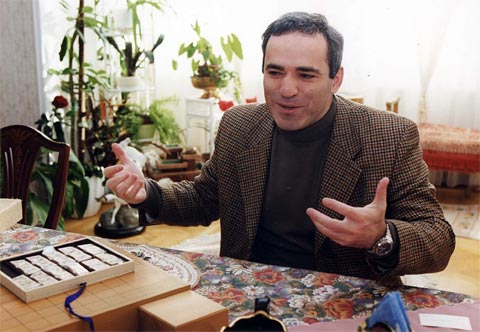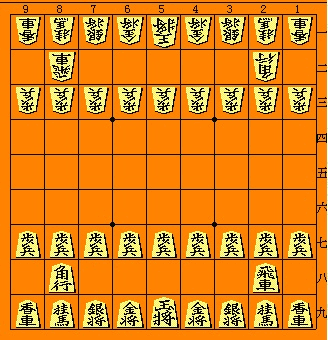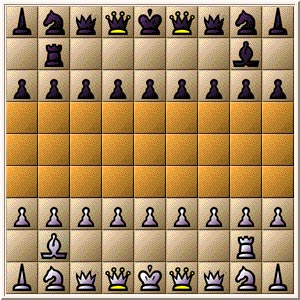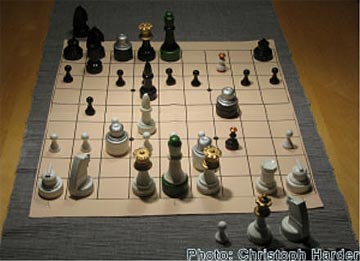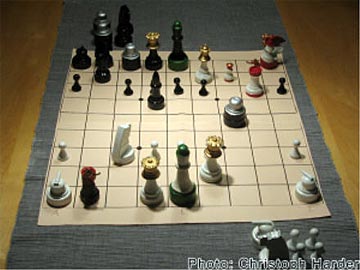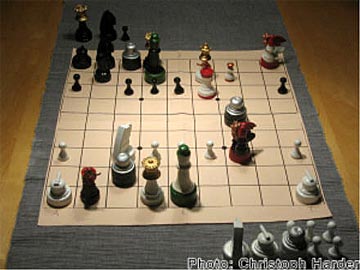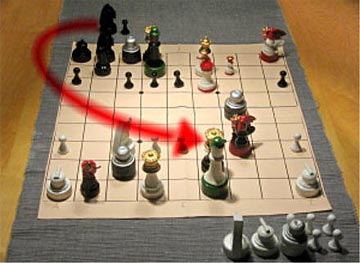Garry Kasparov – taking up Shogi?
01.04.2008 – It was an interesting experiment: the former World Champion has, after his retirement from chess, tried his hand at the Japanese version of the game. Shogi is played on a 9 by 9 uncheckered board with flat wedge-shaped pieces with Kanji characters written on them. In his very first game Kasparov came ominously close to humiliating a three-dan player. Report and game.
Garry Kasparov's Shogi Adventure
Report by Dr. René Gralla
Garry Kasparov is a man with many talents. For a long time he dominated the international chess scene by being the undisputed number one on the board of 64 squares. Today he publishes bestsellers ("My Great Predecessors"), and he has even flirted with the idea of becoming the new President of Russia in 2009.
Parallel to these already time-consuming activities Kasparov has clandestinely tried to unravel the mysteries of Mental Martial Arts from Asia. It has only recently become known, outside Japan, that Kasparov played a match of Shogi – the special Japanese version of chess – some years ago. Courtesy of the "International Shogi Popularization Society" (ISPS), ChessBase has received permission to publish those sensational photos that show Garry Kasparov playing Shogi.

It all started when Eiichiro Ishiyama, a journalist working for the agency Kyodo News, succeeded in getting an interview with Garry Kasparov at his residence in the suburbs of Moscow. Ishiyama is also an amateur Shogi player with a three-dan strenght. The main topic of the interview was about whether artificial intelligence could exceed human beings. Just before the pre-arranged interview time was over, Ishiyama set up a Shogi board which he had brought from Japan. Kasparov knew a little bit about the game, but not exactly how to playit. Ishiyama taught Kasparov how the pieces move and some rules that are sufficient to enjoy the game. Then the game started. Kasparov gradually got serious and he continued the game until the end – even though his mother protested several times that the agreed interview time was over.
After the match Kasparov said, 'Shogi is a unique game. I will have to learn it more thoroughly. I would like to go to Japan." The German daily "Neues Deutschland" ran a feature on this historic experiment (the charge for reading it is EUR 0.65).
Rules of Shogi (将棋)
This is what it a Japanese Shogi board looks like in real life:
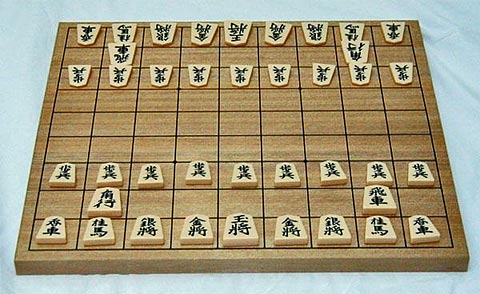
And this is what the starting position looks like in a typical Japanese Shogi diagram:
Douglas Crockford's web site describing the rules of the game says: "If you undertook the task of designing equipment for Shogi with the sole objective of discouraging [Western] chess players from wanting to learn it, it would be hard to improve on the traditional Shogi equipment. It is played on an 9 by 9 uncheckered board with flat five-sided pieces. Each piece has a Kanji character written on it, often in a cursive script that even Japanese people have difficulty reading. A new player must learn to read several Kanji characters, right-side-up and up-side-down."
To make this excellent game more attractive to the rest of the world, Crockford and his group have styled it to look more like chess. After transforming the original Japanese design into westernized optics, this is the initial battle order of Shogi:
And in order to make players of Western chess feel more comfortable in the exotic scenario of Shogi Crockford has produced the prototype of a set of Shogi that is based on figurine pieces:
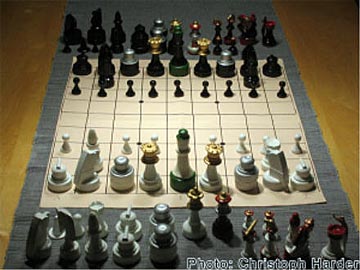
If you are interested in learning the rules of the game you can visit Douglas Crockford web site or go through this extensive (and excellent) primer on Wikipedia.
Kasparov vs Ishiyama
Shogi players are ranked from 15 kyū to 1 kyū and then from 1 dan upwards (the same terminology as in karate, go, calligraphy and many other arts in Japan). Professional players operate with their own scale, from professional 4 dan and upwards to 9 dan for elite players. Kasparov's opponent was just one below a professional Shogi master.
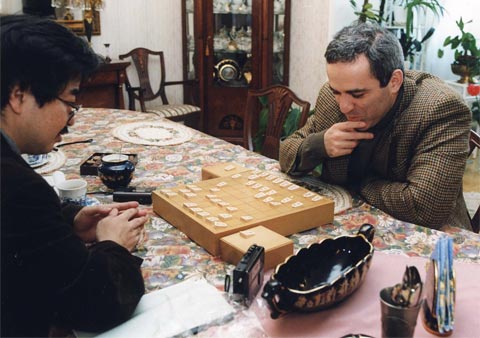
White: Garry Kasparow (highest Elo 2851)
Black: Eiichiro Ishiyama (3 dan)
March 1999, Moscow, residence of Garry Kasparow
Genshi Sujichigai Kaku - Primitive Parallel Diagonal Bishop
1.... g7-g6 (1.P7f …). Remember: in Shogi Black has the right to start the game. 2.c3-c4 Bh8xb2 promotes?!? (1…. P3d 2.Bx2b+ ?!? …) Usually that early exchange will be avoided by players of Shogi. But Ishiyama exchanges the bishop after having been asked by Kasparov to do so because Kasparov wants to study the effect of that move. 3.Sc1xb2 b7-b6 4.g3-g4 b6-b5 (2…. Sx2b 3.P2f P7d 4.P2e …). Ishiyama threatens the early push to b3 (2c) by 5....b4 (5.P2d ...). 5.Sb2-c3 ... (4…. S3c). This prevents 5....b4 (5.P2d ...).
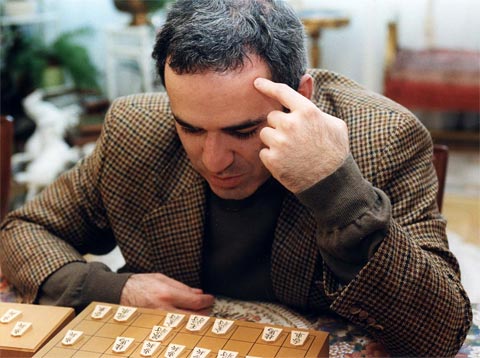
5.... Gf9-g8 6.Nh1-g3 Sg9-h8 7.h3-h4 Sh8-g7 8.h4-h5 B-d6 drops! (5.G7h N7c 6.S8 h P8d 7.S7g P8e 8.B*4f ! …). The black bishop pins White Ng3 (N7c), since the white Rh2 (R8b) is diagonally positioned behind Ng3 (N7c). 9.Sg1-f2 Sg7-f6 10.h5-h6 ... (8…. S6b 9.S6f P8f). Typical Kasparov: he seeks early confrontation, even in the fairly unknown territory of Shogi.
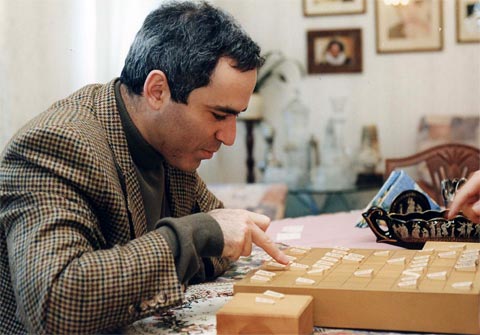
10.... h7xh6 11.Rh2xh6 P-h7 drops! (10.Px8f Rx8f 11.P*8g ! …). The drop of the black pawn seals off the vertical h (vertical 8) file and attacks the white rook. 12.Rh6-h1! ... (11. ... R8a!). Kasparov does not walk into the trap of taking the black pawn g6 (P7f), which is full of poison: 12.Rxg6?? Gg7! (11. ... Rx7f?? 12.G7g ...), and the white rook is lost. 12. ... Nh9-g7 13.B-d4 drops g6-g5 14.g4xg5 Sf6xg5 15.P-g6 drops! ... (12.N7g B*4d 13.P7e Px7e 14.Sx7e P*7f). A "tesuji" – "clever move" – by Kasparov. He attacks the black knight which cannnot the thrust. 15.... P-g4 drops! (15.P*7d ! … ). In Shogi counter-attack is the best defence. 16.g6xg7 promotes g4xg3 promotes 17.pr.Pg7xg8 ... (15…. Px7g+ 16.Px7c+ +Px7h)
Now the race is on: who will be the first to get at the opponent's king? 17. ... pr.Pg3xf2 check 18.Gf1xf2 ... (17.+Px6b Gx6b). At this moment White has gained a material plus: there are one Gold General, one Knight and two Pawns in Kasparov's reserve. In comparison Ishiyama has only captured one Silver General and one Knight. 18.... b5-b4 (18.P2d …). Ishiyama is undisturbed: He attacks on the right wing. 19.Bd4xi9 promotes b4xb3 promotes 20.Rh1xh7 promotes ... (18…. Bx9i+ 19.Px2c+ Rx8g+). Kasparov has managed to promote his rook: Ishiyama's king can smell the smoke and fire that the white Dragon King is spitting. 20.... pr.Pb3xc3! 21.Nb1xc3 Rb8-b1 promotes 22.G-f8 drops & check ... ( 20.+Px3c! Nx3c 21.R2a+ G*6h)
Ishiyama's black king has reason to be nervous: Kasparov's task force of white Gold General f8 (6h) plus the promoted white pawn (Japanese: "tokin") is closing in, and the white dragon king h7 (8g) und white dragon horse i9 (9i) are eager to join the fight. 22.... Ke9-d8 23.Gf2-e2 S-c2 drops! (22.K4h G6b-5b 23.S*3b ! …). The last drop takes advantage of the pin of white Gold General d1 (G4a). 24.Ge2-d2 Sc2xd1 promotes & check 25.Gd2xd1 S-c2 drops! (23…. G5b-4b 24.Sx4a+ Gx4a 25.S*3b ! …). That's Shogi: the second wave of paratroopers glides in out of the blue. 26.pr.Rh7xf7 ... (25…. +Rx6g). The relief attack comes too late. 26.... Bd6-g3 promotes & check (26.B7c+ …).
White is lost. The black bishop rushes forward, from d6 (4f) to g3 (7c); and, by promoting to a dragon horse on g3 (7c), the promoted bishop checks the white king on e1 (5a). I. If 27.Ke1-d2 ... (26. ... K4b), then: 27.... pr.Rb1xd1# (27.+Rx4a#) ;II. if 27.Ke1-e2 ... (26. ... K5b), then: 27.... pr.Rb1xd1# (27.+Rx4a#) ;III. if 27.Ke1-f1 ... (26. ... K6a) then: 27.... G-f2 drops # (G*6b#).
The black Gold General flies directly in to f2 (6b) and, being backed up by Ishiyama's Dragon Horse on g3 (7c), checkmates the white king on f1 (6a). IV. Last try: 27.S-f2 drops ... (26. ... S*6b). No change: 27…. pr.Rb1xd1# (27.+Rx4a#). Consequence: 27. Resigns (26…. resigns). 0-1.
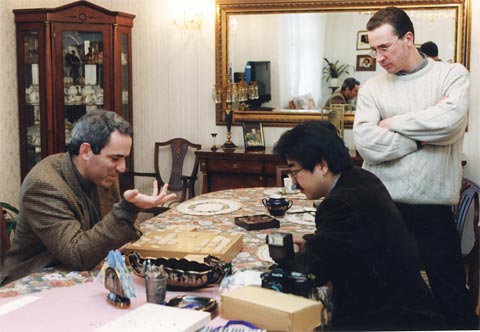
This dramatic duel does Garry Kasparov great credit: The "Beast from Baku" came ominously close to defeating a 3 dan Japanese Shogi player Eiichiro Ishiyama. You can replay the game on this interactive Java Shogi board.
